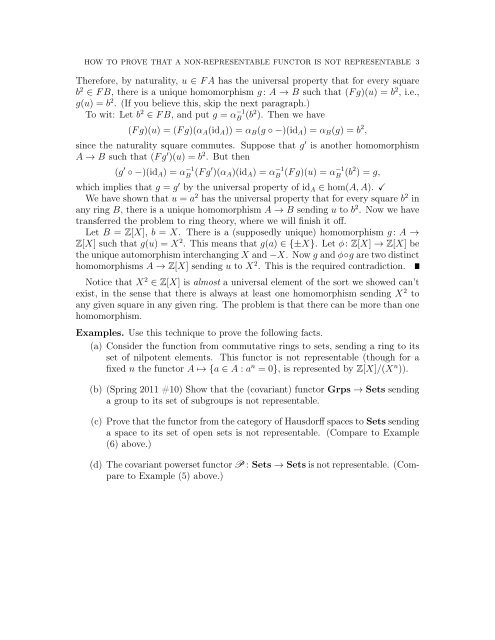HOW TO PROVE THAT A NON-REPRESENTABLE FUNCTOR IS ...
HOW TO PROVE THAT A NON-REPRESENTABLE FUNCTOR IS ...
HOW TO PROVE THAT A NON-REPRESENTABLE FUNCTOR IS ...
You also want an ePaper? Increase the reach of your titles
YUMPU automatically turns print PDFs into web optimized ePapers that Google loves.
<strong>HOW</strong> <strong>TO</strong> <strong>PROVE</strong> <strong>THAT</strong> A <strong>NON</strong>-<strong>REPRESENTABLE</strong> FUNC<strong>TO</strong>R <strong>IS</strong> NOT <strong>REPRESENTABLE</strong> 3<br />
Therefore, by naturality, u ∈ F A has the universal property that for every square<br />
b2 ∈ F B, there is a unique homomorphism g : A → B such that (F g)(u) = b2 , i.e.,<br />
g(u) = b2 . (If you believe this, skip the next paragraph.)<br />
To wit: Let b2 ∈ F B, and put g = α −1<br />
B (b2 ). Then we have<br />
(F g)(u) = (F g)(αA(idA)) = αB(g ◦ −)(idA) = αB(g) = b 2 ,<br />
since the naturality square commutes. Suppose that g ′ is another homomorphism<br />
A → B such that (F g ′ )(u) = b 2 . But then<br />
(g ′ ◦ −)(idA) = α −1<br />
B (F g′ )(αA)(idA) = α −1<br />
B<br />
(F g)(u) = α−1<br />
B (b2 ) = g,<br />
which implies that g = g ′ by the universal property of idA ∈ hom(A, A). <br />
We have shown that u = a2 has the universal property that for every square b2 in<br />
any ring B, there is a unique homomorphism A → B sending u to b2 . Now we have<br />
transferred the problem to ring theory, where we will finish it off.<br />
Let B = Z[X], b = X. There is a (supposedly unique) homomorphism g : A →<br />
Z[X] such that g(u) = X2 . This means that g(a) ∈ {±X}. Let φ: Z[X] → Z[X] be<br />
the unique automorphism interchanging X and −X. Now g and φ◦g are two distinct<br />
homomorphisms A → Z[X] sending u to X2 . This is the required contradiction.<br />
Notice that X 2 ∈ Z[X] is almost a universal element of the sort we showed can’t<br />
exist, in the sense that there is always at least one homomorphism sending X 2 to<br />
any given square in any given ring. The problem is that there can be more than one<br />
homomorphism.<br />
Examples. Use this technique to prove the following facts.<br />
(a) Consider the function from commutative rings to sets, sending a ring to its<br />
set of nilpotent elements. This functor is not representable (though for a<br />
fixed n the functor A ↦→ {a ∈ A : a n = 0}, is represented by Z[X]/(X n )).<br />
(b) (Spring 2011 #10) Show that the (covariant) functor Grps → Sets sending<br />
a group to its set of subgroups is not representable.<br />
(c) Prove that the functor from the category of Hausdorff spaces to Sets sending<br />
a space to its set of open sets is not representable. (Compare to Example<br />
(6) above.)<br />
(d) The covariant powerset functor P : Sets → Sets is not representable. (Compare<br />
to Example (5) above.)
















